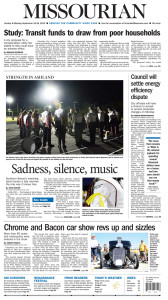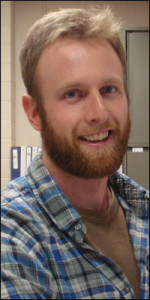Seth Boster and Brendan Gibbons Win Dean’s Award for Feature Writing in Mastering the Method Contest

The Competition Recognizes Outstanding Work by Undergraduates
Columbia, Mo. (Nov. 11, 2013) — Seth Boster and Brendan Gibbons are the winners of the Dean’s Award for feature writing in the Mastering the Method Contest at the Missouri School of Journalism.
The new contest recognizes outstanding work by undergraduates in the areas of broadcast, multimedia, photography and writing. The top two winners in each of the 14 categories receive a $100 gift card.
Boster and Gibbons work was selected from among 68 entries, Dean Mills, dean, shared during the announcement ceremony on Nov. 7 in the Columbia Missourian newsroom.
Information about Boster and Gibbons’ entries and the judges’ comments are as follows.
Seth Boster: “After Tragedy, Southern Boone Marching Band Plays On.” Boster’s article was published Sept. 15 in the Columbia Missourian. Faculty editor was Greg Bowers. Boster is a junior studying print and digital news.
Judges’ Comments: “Seth Boster did a terrific job of listening and seeing. He captured an intimate and emotional moment in the life of the Southern Boone High School band and wove together its members’ memories of classmate Jacob Meadows and how they learned of and dealt with his death. Seth’s piece was a good example of observational storytelling. He went to Ashland and put together a story that showed that community dealing with a stunning tragedy. And the response from readers was overwhelming.”
Boster shares how he came to write this article:
I followed the news reports coming out of Ashland that week like many in the area. On Tuesday, as details emerged of Jacob’s suicide from earlier in the morning, I had an initial thought to go to the Southern Boone home football game that coming Friday. At first, I was curious to see how something as normal and mundane as a football game could go on in a small town immersed in such grief. What would that scene be?

I’ve tried to never go into an assignment with any assumptions on what the story was. Though I was curious about how the scene at the football game would play out, I didn’t want to assume that that was where the story was. Obviously, I knew very little about Jacob, and I first of all wanted to go to Ashland to learn about who he was, what he meant to the people there. What I knew as I drove to Ashland that Friday afternoon was two things: He was involved in band, and his memorial service would be held only hours before the football game. I started by going to Southern Boone High School, where I talked to Andrew Marjamaa, the band director, at the end of the school day.

He talked with me about Jacob’s involvement in the band and about the friends he made in it. These were Jacob’s closest friends. He told me about how those friends were grieving, and then about how they planned to honor Jacob later that night during their halftime show at the football game. But before that, they were all going to Jacob’s memorial service. I knew then that I wanted to follow their story.
My greatest struggle through the whole reporting process was coming to terms with being a journalist, a stranger in a setting that was extremely personal and emotional. I knew I had to go to the memorial service, because I knew that would be my best chance to learn about Jacob and about what he meant to those grieving, but I struggled with the awareness of being a stranger. I managed to put myself in the line of people stretching to the front of the church where Jacob’s family stood. I felt like I just needed to shake their hands to pay my respects, and to tell them the truth: I didn’t know Jacob, but I was learning about Jacob. I think we all tend to put our reporter caps on our heads and forget that we’re human, and that’s a dumb thing to forget.
I watched Jacob’s bandmates in their marching uniforms file into pews that were reserved for family and listened to many of them eulogize behind the church’s podium. I later followed them out of the church to see them grieve outside. Mr. Marjamaa invited me to follow them along to the band room back at the school. He later introduced me to some of Jacob’s friends and later asked me if I’d like to follow them to the side of the field before halftime, where they held hands in a circle and said they loved each other and told themselves that they were about to play for “Jake the Great.”
I was so struck by the courage of these young people to be able to grieve and then honor a friend that left them behind. I hoped that by stringing together the details in their moments that I could somehow illustrate the strength I saw for readers.
I went to Ashland like I’ve gone to any assignment – without expectation. I certainly couldn’t have imagined the response the story received, from Jacob’s friends and family saying the story helped in their healing. I’m incredibly honored by this recognition from the Missouri School of Journalism, but I feel the greatest reward for me was in the lessons I learned in Ashland.
Brendan Gibbons: “Radium Game: The Life and Legacy of Herman Schlundt.” Gibbons’ article was published July 15 in the Missourian. He was enrolled in the science and agricultural journalism program and graduated in May. He is now an environmental reporter for the Times-Tribune in Scranton, Pa. Faculty editor was Jeanne Abbott.
Judges’ Comments: “Brendan Gibbons did a masterful job of detective work, piecing together a rich portrait of an MU professor and chemist who died more than 75 years ago, and connecting his work to the contamination of a building the university is still struggling to resolve.
Gibbons shares how he came to write his article:
I became interested in Herman Schlundt’s research after seeing him mentioned in MU News Bureau press releases about Pickard Hall‘s temporary closure. They simply mentioned his name and said he conducted research on radiation in the early 20th century.

The lack of details left me curious. “Who was this guy, and what exactly were his experiments?” I searched his name, and the first hit was a description of a State Historical Society of Missouri collection of his documents. I started there, but my search took me to the University Archives, the Boone County Recorder’s Office, the stacks of Ellis Library and the dustiest corners of the Internet.

Truthfully, much of this research was boring. I spent weeks reading hundreds of letters Schlundt wrote stretching from the early 1900s to the mid-1930s. I almost gave up a few times, tired of reading letters about textbook recommendations Schlundt offered to rural high school chemistry teachers, for example. But here and there I found clues to where Schlundt got the raw materials he used to refine radium and thorium and how he benefited from his work.
One big “Eureka!” moment came when I found a series of letters between Schlundt and Harlan Miner of the Welsbach Company. Their correspondence lasted for years, and the letters between the two formed the foundation of my story. Another great moment came when I found a letter in the University Archives from Marie Curie to Miner, asking him to thank Schlundt for a donation of thorium to her lab. I knew I had something valuable when I found a third letter, in which Schlundt wrote, “To secure the [thorium] we must have the good will of Dr. Miner of the Welsbach Company, as it is through his firm we get our supply of [raw materials].” This letter also confirmed that Miner was paying Schlundt to use university equipment, lab space and student labor to operate an industrial refinery.
Overall, I was pleased to have an opportunity to tell an untold story that linked the university’s present with its past. I got a chance to draw from primary documents, and I am incredibly grateful to the staff at the State Historical Society and the University Archives for their help. We should never take such libraries for granted. They hold countless stories still waiting to be told.
Updated: July 21, 2020